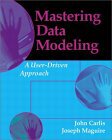Data Modeling: It's All in the Approach
Our reviewer says this book on data modeling, while somewhat dry, is one of the best resources available on this topic.
by Damir Bersinic
11/7/2001 --
With any theoretical topic there is an inherent level of obfuscation that exists simply because you’re dealing with theory and not concrete elements. This can make getting the design of a database particularly tricky, because too many database administrators and programmers think of the physical data structure without looking at what the database is supposed to contain. This is where data modeling fits in.
In "Mastering Data Modeling: A User-Driven Approach," John Carlis and Joseph Maguire present a step-by-step approach to creating a data model by using the Logical Data Structures (LDS) notation and process. The book presents each potential problem that you could run across in a succinct chapter (many chapters are only a few pages in length) and then provides a solution. It starts with the basics, such as what an entity or an attribute is, to how they should be represented diagrammatically, and then moves on to relationships, constraints and so on. At the end of each chapter one of my favorite features: a set of exercises that further helps to reinforce the concepts outlined by the authors.
The authors have not only concentrated on the data model itself but have also touched upon how to communicate the information to users and on getting users involved in the modeling process. This is a critical element in the design of any database and is too often overlooked by many organizations. Although the topic is very theoretical, very practical suggestions are incorporated throughout the book to make creating a data model in the real world easier.
The faults of this title are more stylistic than anything else. I like the content and it is well presented; however, the style of the book reminds me of textbooks I read in university (and often fell asleep to). Both of the authors have strong academic backgrounds and one is still a university professor, which may account for this. While they have toned down the academic tone of the book somewhat, an assumption about a certain level of knowledge by the reader is apparent in the language and tone of the book. In other words, your great-aunt who can surf the net probably would not be able to understand what is being presented, but anyone with some database background should be able to get through it.
If you are looking for a book that succinctly outlines how to create data models and provides a workable approach to the topic that can be understood by users with a database or business process background, this one is for you. Those just starting out may find this book a bit of a tough go, but the exercises at the end of each chapter may help in understanding the topics presented.
Have you read this book? Let us know what you think! Rate it below or visit our Forums.
Damir Bersinic is an Infrastructure Consultant with Trecata Corporation, a systems integration consultancy in Toronto, Canada. He has more than 20 years of industry experience and has written a number of books on Oracle, Windows, SQL Server and Active Directory. His most recent book is "Portable DBA: SQL Server" from Osborne McGraw-Hill. He is also an Oracle Certified Professional (DBA), MCSE, MCDBA and MCT. He can be reached by e-mail at .
More articles by Damir Bersinic:
|

 Book Review Article
Book Review Article
